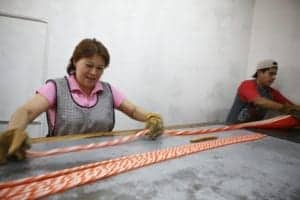Mexico shows great promise in driving women’s financial inclusion and realizing the economic potential of doing so. While there is much work to be done, many of the barriers are surmountable. Women’s World Banking will be leveraging payment digitization and women-centered design to enhance user experience, financial capability and ultimately increase women’s access to and usage of financial services in the country.
More than half of the unbanked people in the world are women and the gender gap has remained persistent. This represents an untapped market opportunity for financial institutions, one that offers good returns. Financial inclusion can get you a long way to better water, sanitation, food security, better education, better health, but women’s financial inclusion can get you there faster. Mexico is no exception.
Mexico has a financial inclusion rate of 44 per cent and a small gender gap of 4 percent. While Mexico shows great promise in its commitment to women’s financial inclusion, there is significant work ahead of us to ensure that low-income women are not left behind. Imagine what the Mexican economy would look like if we doubled-down on our efforts?
Let’s paint the picture.
There is immense opportunity
Research shows that women are natural savers despite low and often unpredictable incomes. The women in Mexico provide an incredible opportunity if given the right tools to succeed. It is a country of untapped entrepreneurs and immense international investment.
Women’s World Banking’s studies show that women are the main remittance recipients, having received approximately 72 per cent of the US$ 27 billion in 2016. Despite advances in technology for transferring the money, once received this is mostly managed in cash and is often used in non-productive ways.
Mexican women are untapped entrepreneurs. Women in Mexico do not own businesses at the same rates of men and the disparity is clear. They own 29 per cent of microenterprises, 19 percent of small firms, 6 percent of medium firms and 7 per cent of large firms. Increasing the number of women entrepreneurs would boost the country’s GDP by 43% by 2025.[1]
The hurdles are surmountable
According to the Global Findex, there are 31.5 million unbanked women in Mexico There are an additional 3.2 million women with inactive accounts.

The current system has many hurdles that have negatively affected full inclusion of the financial system. In order for women to get money, they are faced with the less than ideal choices of going to ATMs, which often impose security threats and technical difficulties, or they can go to retail stores, which are more practical but not as accessible. Alternatively, pawnshops and money-lenders offer flexible, and immediate alternative solutions but do not help grow their financial independence. In order to increase adoption, financial services providers need to make themselves more accessible.
We cannot just assume that because technology exists, financial inclusion will exist as well. There are still a lot of cultural and social norms that make it very difficult for low-income women to have a cell phone of their own. Even if they do, the learning curve is steep and concerns for privacy are prevalent. Product design and user experience of digital financial products is created with the end-user in mind.
Mexico’s financial market is dominated by few large players that lack product differentiation and flexibility. Currently many of these large players provide standardized high-cost, credit-led products. This uniformity creates a barrier for low-income women from accessing products because they aren’t relevant to her needs. Financial services providers need to challenge the status-quo and create products that promote full inclusion.
What’s next?
Against this backdrop in Mexico, Women’s World Banking aims to enable more low-income women to take up and actively use a formal savings account. To solve this problem, Women’s World Banking will be working with financial service providers in a number of ways.
Leveraging the increase in bulk payment digitization, Women’s World Banking will partner with financial service providers to deepen women’s engagement with financial services by enhancing women clients’ financial capability and increasing awareness of and improving the user experience of their product offering. In the same vein, Women’s World Banking sees opportunity in digitizing and linking remittances to bank accounts as an onramp to more financial services.
Women’s World Banking is also looking to include one of the most neglected segments of the market—elderly low-income women who worked in the informal sector—by exploring ways to safely keep and increase their retirement savings.
In all this work, Women’s World Banking will optimize product design and user experience using behavioral insights to drive a more digital ecosystem which will enhance and scale financial access points in Mexico and ultimately increase women’s access to and usage of financial services.
[1] http://www.cherieblairfoundation.org/2018/03/07/forging-a-road-to-growth-for-mexican-women-entrepreneurs/


